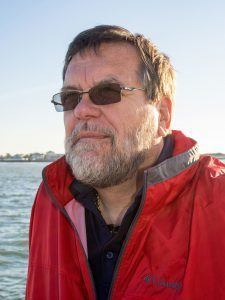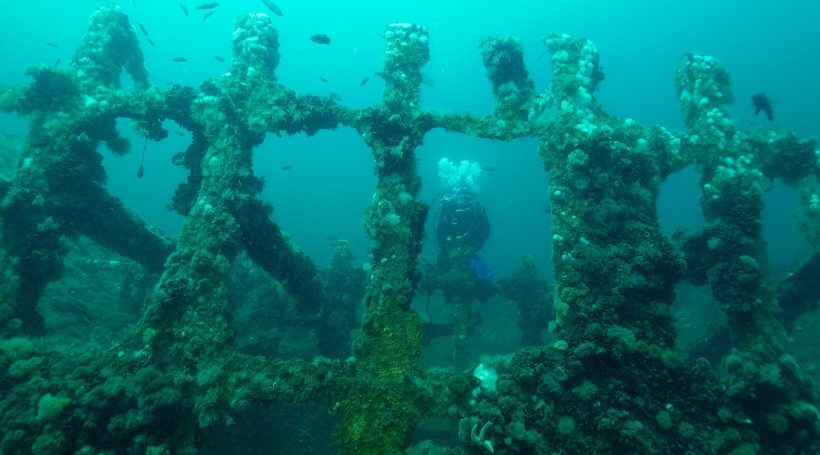It’s impossible to say how many shipwrecks lie in the murky depths of the waters off New Jersey. Some estimates put the number around 4,000. Others say there are as many as 7,500. What is certain is these wrecks are a proving ground for divers around the world. As local divers are quick to say, if you can dive here, you can dive anywhere.

Capt. Steve Nagiewicz
“There are probably 3 million shipwrecks in the world, and 100,000 or more just in the United States,” says Steve Nagiewicz, a diver and professor of marine science at Stockton University. “New Jersey is sandwiched between the port of New York and the port of Philadelphia, and for a few hundred years those were the two busiest ports in the world. Lots of ships went up and down the coast, and there was ample opportunity for them to sink.”
Nagiewicz, 63, is the author of “Hidden History of Maritime New Jersey,” published in April of this year. The book documents the many wrecks off New Jersey that are considered notable, both for their historical impact and what it takes to get to them.
“A lot of divers will say this: If you can dive in the cold, murky waters off New Jersey, you can dive anywhere in the world,” Nagiewicz says. “The wrecks are interesting not just because they’re difficult to get to, but also because of their impact on maritime history. Quite a lot of them had an impact on commerce and shipping safety into the future.”
One such wreck is the Mohawk, a steamship traveling between New York and Havana, Cuba, which got into a collision just off the Point Pleasant Inlet.
“It was a clear night; everyone could see both ships coming, but still they collided and the Mohawk sank,” Nagiewicz says. “It was a tragic event, and it led to the Coast Guard having more stringent regulations for passenger safety.”
While ships like the Mohawk are easily identifiable, many wrecks have lost all the markings and details that signify what they were. That’s where Dan Lieb, president of the New Jersey Historical Divers Association (NJHDA), comes in. He and his team search newspaper archives and Coast Guard reports to identify shipwrecks that are, in some cases, more than a century old.
“After a generation or two or three, people just don’t know what they are,” Lieb says.
“What we do is go out and look at what’s on the bottom, and that’s the face. We see what’s in the newspaper, and that’s the name. We put a name with a face. We average about one wreck a year, and we’ve identified 14 so far.”
Of the wrecks the NJHDA has identified, Lieb says the most meaningful to him is the John K. Shaw, which wrecked off Manasquan.
“It was a vessel built at City Island, New York and owned by people who lived in Manasquan,” Lieb says. “So this wasn’t just a foreign crew. These were locals that died on a local wreck. It has all the makings of a hit-and-run at sea. Families in the area, descendants of the families on board that boat, remember the incident today. It’s a rather engrossing, local story.”
Another interesting identification was that of U-869, a German U-Boat 60 miles off Cape May. The location of the submarine is particularly puzzling, Lieb says, because for several decades it was thought to have sunk off the European island of Gibraltar.
Nagiewicz says divers head to the ocean floor for lots of reasons. For some, diving a shipwreck is a routine fishing expedition.
“If you’re brave enough, you can stick your hand in a wreck and pull out a lobster,” he says. “I’ve had my thumb broken doing that. You have to be quick.”
Others are after more traditional treasure, like gold and silver coins or similarly valuable artifacts.
“There are some wrecks people go after because they were carrying treasure,” Nagiewicz says. “After a storm, Spanish doubloons [gold coins] sometimes wash up on the beach at Sea Girt. We took our sonar out one day about 15 years ago and found a spot that was likely the wreck, buried under 20 or 30 feet of sand. It’ll never be dug out, but once every few years, a lucky prospector will find a Spanish doubloon.”
“The Delaware sank a mile and a half off the beach, at the height of the Spanish American War,” he continues. “It’s assumed it was carrying $250,000 in gold for payroll for soldiers in Cuba. The wreck has been explored, but no one has ever found the money.”
For still other divers, just the experience of reaching a wreck is worth its weight in gold. Nearly 100 miles off the coast of Manasquan lies the Andrea Doria, a diving Mecca widely considered “the Mount Everest of shipwreck diving.”
“At her deepest point, she lies in about 240 feet of water, but the wreckage starts at about 190 feet,” Lieb says. “The Andrea Doria is in an area known for its currents. Divers have tried to get down to it and have aborted their dive because they can’t get down. People have said the divers floating in the current look like laundry on a line. Sometimes you get to the wreck, and you can only see 5 feet in front of you.”
If you do make it into the wreck, Lieb says, you then find a whole additional slate of issues to contend with.
“It’s covered in nets, and it’s falling apart,” he says. “It’s in a prime fishing area, and in the ’60s and ’70s the Russians would come in and try to do surveillance on the U.S. under the guise of fishing. They were unfamiliar with the area and would catch their nets. You could get lost inside. You could run out of air. You could get tied up in it and run out of air.”
Though Lieb doesn’t discourage divers from attempting the Andrea Doria, he does warn that proper preparation is key to survival.
“There were 50-odd people who died when she sank in 1956,” he says. “If divers don’t watch it, we’ll have the same number of divers – or more – who’ve died on the wreck.”
Though Lieb has never attempted to dive the Andrea Doria, he has long been passionate about exploring wrecks in shallower waters. He’s got his own treasures – though most are surprisingly commonplace.
“The first artifact I found was a valve from the engine room of a boat called the Rusland off Long Branch,” he says. “[Famous treasure hunter] Mel Fisher was making great discoveries in Florida, bringing up gold and silver. My dad looked at it and said, ‘Mel Fisher brings home gold, and you bring me broken plumbing.’”
Nagiewicz too has held onto some artifacts that many wouldn’t consider valuable. A few years ago, though, he donated the majority of his collection to museums.
“I collected artifacts for years, and one day I woke up and said, ‘It would be nicer if other people could see the history that’s off New Jersey,’ and I donated all those things to museums,” he says. “I’m hoping more divers will do the same. It’s nice to have that porthole in your house, but it’s more exciting to know it’ll be in the museum where hundreds, maybe thousands, of people can see it.”
Some of Nagiewicz’s finds ended up at the New Jersey Shipwreck Museum in Wall, where Lieb serves as curator and director.
“After the NJHDA formed in 1992, we decided we needed to share this history with a wider audience,” Lieb says. “We established the museum in 2006, and we recently entered into a lease to expand into a much larger building. It will be an opportunity to produce interactive displays that will better explain to people how science and diving and shipwrecks and history all combine. And there’s a lot of meat on the bone there.”
Lieb is unendingly passionate about the discovery and identification of shipwrecks. To him, each wreck tells the story of the people aboard and represents a snapshot of American maritime history.
“Shipwrecks, generally speaking, are very protracted events,” he says. “Car accidents, airplane crashes and train wrecks happen very fast. They’re all instantaneous. But with shipwrecks, even if the incident that causes them to sink – like a torpedo or boiler explosion – happens fast, the vessel sinking, people drowning, that happens slowly. So there’s this story of courage and terror and survival that’s all wrapped up in these wrecks. Shipwrecks are very much human stories, and I like being able to tell them.”












